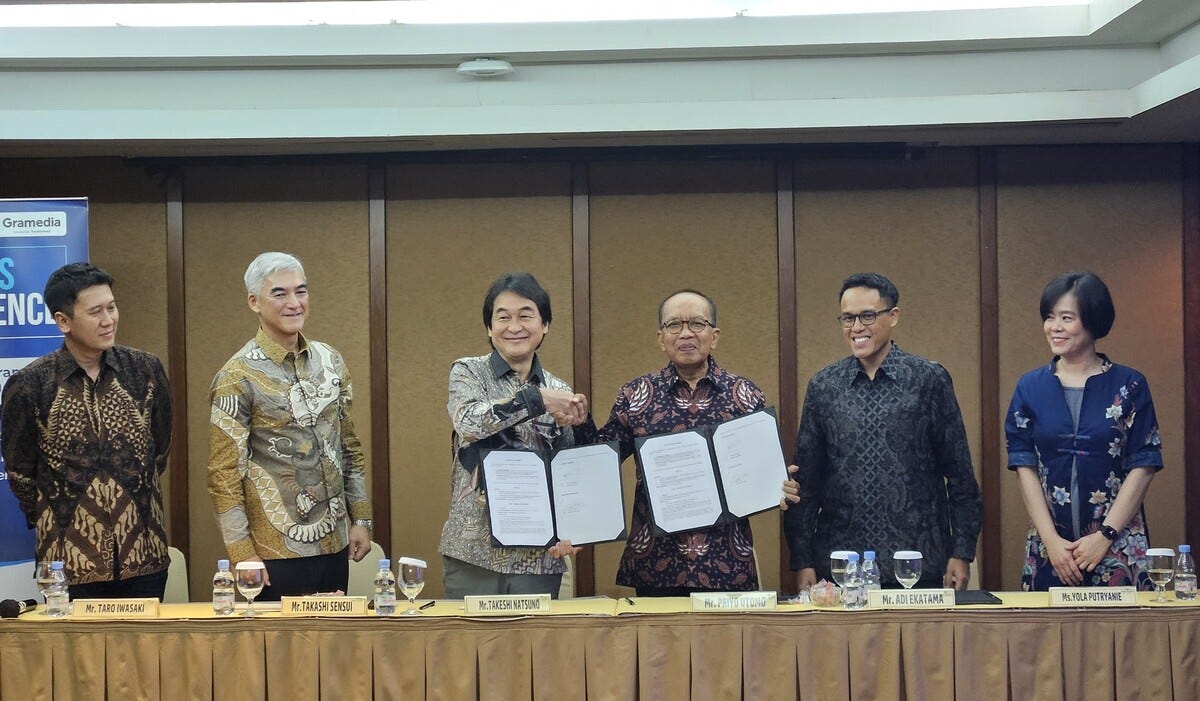Anime ambitions in 2024 face labor headwinds
Plus: Manga digital distribution goes global in 2024; Why TV networks invest in anime productions; Kadokawa ventures into Indonesian market; and more
This is your weekly Animenomics briefing, covering the business of anime and manga. Today is Wednesday, January 10, 2024. Happy new year!
In case you missed it: Hayao Miyazaki’s The Boy and the Heron was named Best Animated Motion Picture at the 81st Golden Globe Awards on Sunday, becoming the first anime film to win a Golden Globe trophy.
A decade ago, Miyazaki’s previous film The Wind Rises was a nominee for Best Non-English Language Motion Picture at the 71st Golden Globe Awards.
Renewed interest in Japanese IP faces labor headwinds
With the overseas anime market poised to overtake the domestic market, there is increasing pressure on Japanese anime studios to produce more content, but the industry is still plagued with labor challenges.
Why it matters: Successes in western adaptations like The Super Mario Bros. Movie and One Piece last year are expected to bring renewed interest in Japanese content in 2024, writes anime journalist Tadashi Sudo.
What’s happening: New anime productions are rising, continuing a trend that has been occurring since 2019.
Data from the Association of Japanese Animations’s latest Anime Industry Report shows that the ratio of new to existing anime productions reached a record high in 2022.
Yes, but: New anime productions don’t necessarily mean new properties. Businesses are focusing on already popular titles, which are considered less risky than developing an entirely new property, Sudo writes.
Zoom in: The average number of anime productions annually in the last decade is 50 percent higher than in the previous one, but staff numbers remain stagnant.
Studios can’t hire enough staff and are forced to hire unskilled workers, leaving training to veteran animators, who are already stretched thin.
The Nippon Anime & Film Culture Association, a labor group, is designing a skills test to teach and evaluate aspiring animators to help studios’ hiring process.
Between the lines: Despite the labor shortage, today’s anime labor market isn’t the same as the one from the early and mid 2010s.
Sudo says wages are on the rise for animators (though still low by western standards), and more studios are reducing and banning late-night work and excessive overtime.
Digital distribution makes manga a global experience
Japan’s manga publishers have lagged behind South Korea’s webtoon companies when it comes to digital distribution, but they are now embracing distribution at a global scale, according to the Nikkei financial newspaper.
Why it matters: Manga apps, which grew in popularity during the COVID-19 pandemic, are becoming an important part of publishers’ distribution strategy.
Catch up quick: Publishers like Shueisha and Kodansha are leaning on their new international manga apps to publish translated chapters at the same time as Japan.
When Kagurabachi began serialization in Weekly Shonen Jump magazine last September, simultaneous release on MANGA Plus helped it generate more searches online than popular titles like Spy × Family did at their debut.
Simultaneous translations have reduced the time it takes to release manga outside Japan from years to hours.
By the numbers: Tokyo-based MediBang, a manga translation and illustration software company, has seen translation requests from publishers increase by 20 to 30 percent annually.
Yuta Momiyama, deputy editor-in-chief of Shueisha’s domestic Shonen Jump+ app, said on X (Twitter), “MANGA Plus was launched for readers around the world, but it also has a function like a catalog for industry people that can lead to translation and publication overseas and screen adaptations.”
Yes, but: “The impact of pirated copies are still present,” says Yuta Hiraoka, the deputy editor-in-chief of Kodansha’s Weekly Shonen Magazine.
Overseas revenues still represent a small fraction of the manga market, and the industry is still reliant on print and copyright sales.
Mobile app analytics provider Sensor Tower reports that 77 percent of the revenue from the top 30 manga apps last year came from Japan.
Clippings: Go Nagai museum ruined in quake aftermath

Fire destroyed a museum exhibiting the life and work of manga artist Go Nagai in Wajima, Ishikawa Prefecture, hours after a magnitude 7.6 earthquake struck Japan’s Noto Peninsula on New Year’s Day. (The Hokkoku Shimbun)
The Go Nagai Wonderland Museum was named one of the country’s 88 most popular anime tourism destinations by the Anime Tourism Association.
TV Tokyo Corporation won an intellectual property lawsuit in the United States against more than 300 foreign defendants who allegedly sold counterfeit Naruto merchandise online. (Anime News Network)
Bloomberg Law reports the U.S. federal court in Chicago that delivered the judgment is a popular destination for brands filing counterfeit merchandise lawsuits.
E-book publisher China Literature bought fellow Tencent subsidiary Tencent Animation and Comics for CN¥600 million (US$83.6 million), absorbing a loss-making company that has previously invested in anime adaptations of properties published in Mandarin Chinese. (Publishers Weekly)
South Korean studios are growing the country’s animation scene by partnering with Japanese companies to animate adaptations of manhwa—Korean-language comics—and marketing them as anime, says one manhwa scholar. (Anime Feminist)
TV networks invest in anime, pivot from broadcasting
“I understand the current opinion that it’s better to broadcast on terrestrial networks, but I think this will change in the next 10 years. If you think about the programming-centric nature of television stations, anime has become a business that is ultimately established through streaming, so it has become independent of the programming-centric business.”
— Ryota Fujitsu, anime critic and animation programming advisor for the Tokyo International Film Festival
Context: Japanese television stations, Fujitsu argues, invested money in anime over the past few years to grow revenue from non-broadcast segments such as intellectual property development and distribution.
One of Japan’s leading anime scholars and critics today, Fujitsu made his comments in a two-part discussion with anime columnists Daisuke Watanabe and Hotaka Sugimoto for the Real Sound web magazine.
Fujitsu believes Nippon Television especially has been very proactive in this approach with its investment in Frieren: Beyond Journey’s End and its purchase of Studio Ghibli in September.
Bottom line: “As Mr. Fujitsu said, if we think about 10 years from now, I think there is a sense of crisis that television stations may not be able to survive if they don’t pivot their core businesses now,” Sugimoto added.
Kadokawa partners on aggressive Indonesian expansion

Publishing conglomerate Kadokawa is aggresively expanding its business abroad, collaborating with local players in Europe and Asia to develop anime, manga, and light novel projects in its portfolio.
Driving the story: Kadokawa’s latest investment is a joint venture company with Indonesia’s largest publisher and bookstore chain Gramedia.
The details: A new entity with 51 percent ownership by Kadokawa and 49 percent by Gramedia will translate and publish manga and light novels by Japanese and Indonesian creators and also develop an e-book platform.
Taro Iwasaki, who headed a similar business for Kadokawa in Thailand, will lead the new company named Phoenix Gramedia Indonesia.
Kadokawa is targeting sales of US$10–20 million for the joint venture, Iwasaki told the Kompas newspaper.
Zoom out: Kadokawa told investors in November that it wants to double the ratio of overseas revenue in the next four years.
In the past year, the company has expanded its light novel business to Europe, invested in screen adaptations of Japanese content in Taiwan, and acquired a manga and light novel publisher in Thailand.
Overseas sales for the fiscal year ending March 2023 stood at JP¥52 billion (US$370 million), or 20 percent of total revenue.
The bigger picture: As previously reported by Animenomics, Indonesia boasts a large population of Internet-savvy young adults that are fans of anime and manga.
Kompas reported last month that manga is Gramedia’s third largest publishing category, making up 17 percent of book sales.
Animenomics is an independently-run and reader-supported publication. If you enjoyed this newsletter, consider sharing it with others.






The challenge of sufficient artists / illustrators at the appropriate level depends to a degree on longer term planning - I'm guessing this is by art studio at present. Should the issue be industry-wide, alternate models to develop excellence might work. So in the UK there have been sector wide apprentice schemes, contributed to by relevant industry players. This runs against the jobbing focus for anime but it could be made to work... there is mileage in this given that anime is significant, visible and growing. It goes without saying that there are other benefits to an industry wide body.
Given that Crunchyroll have shut down their commenting (poorly administered btw) it is not easy to provide feed back - in my case this is mostly to encourage writers, animators etc but can also concern personal observations on the quality of scenery / facial expression etc in effect matters that shouldn't really make the final cut... even sub-titling - which sometimes looks like it was done by AI. Such detailed minutiae doesn't belong here but in an overall sense this points to growth without a plan or design (detailed minutiae haha!!)
Some good info in your article!
Terence P